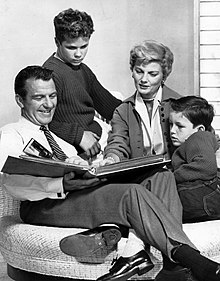Leave it to Beaver
by admin - October 30th, 2017
By Elena Mouradian
Leave It to Beaver, written by Joe Connelly and Bob Mosher, was an American television show released in 1956.
It depicted the everyday life of the Cleavers, an ideal suburban family from the 1950’s. The sitcom’s clean humor and likable cast gave it the popularity to continue on for 6 seasons. There were a total of 234 episodes and the last episode aired on June 20, 1963. Leave It to Beaver received two Emmy nominations in 1958 for Best New Program Series of the Year and Best Teleplay Writing. Although it aired on October 4, 1957 on CBS, the show changed networks in the next season to ABC and stayed there until the end. Each episode was 30 minutes long and shot in black and white. The typical episode will track the everyday activities of the Cleaver family.The show was written from the point of view of Beaver, the youngest son in the family. Beaver is portrayed by Jerry Mathers. The other stars of the show included Barbara Billingsley and Hugh Beaumont as Beaver’s parents, June and Ward Cleaver, and Tony Dow as Beaver’s older brother Wally. A typical episode would show Beaver or Wally getting involved in some kind of adventure that eventually finds them in trouble. Later, June and Ward would teach the children that bad behavior has consequences. Most Leave It to Beaver episodes follow this pattern. The overall content of the show is used to explain how a wrongdoing results in parents teaching their children a lesson with a moral or punishment. This kind of moral guidance was a recurring theme in many shows and often Leave It to Beaver is compared to other wholesome family shows including, Ozzie and Harriet. (Dunar, 236) The theme displays many ideal middle-class values of the 1950’s.
The show encourages many of the stereotypical gender roles, family structure, and clothing attire of the time. The Cleavers are a typical nuclear family that consisted of two married parents living together with their two children. The parents are depicted as being a happily married couple with no problems. They are both college-graduates living a very comfortably life with Ward working in an office and June as a happy homemaker. Any time another kind of family is mentioned whether it be a single mom or divorced parents, Leave It to Beaver describes them in a negative light. The show also encourages the stereotypical gender roles of the time. For example, one episode has Ward describing how women should stay inside where the modern day conveniences make it easier to cook in the kitchen rather than outside where a man should be. For example:
Although Leave It to Beaver contains some debatable concepts, the show was very popular in the 50’s for its display of the ideal American family.
Works Cited:
Dunar, Andrew J. America in the Fifties. Syracuse University Press, 2006.
“Leave It to Beaver (TV Series 1957–1963).” IMDb, IMDb.com,
www.imdb.com/title/tt0050032/.
“Leave It to Beaver.” Wikipedia, Wikimedia Foundation, 23 Oct. 2017,
en.wikipedia.org/wiki/Leave_It_to_Beaver.

Elena, this post was very interesting to read about considering that I have grown up watching “Leave it to Beaver” with my family. Although I always recognized the 1950s stereotypical family and roles within the family in the show, it was interesting to hear about it from another perspective. I also loved how you included the clip that demonstrates the stereotypical gender roles portrayed through the show when Ward is talking to Wally about how people say that a woman’s place is in the home, so “she might as well be in the kitchen” and when Beaver talks to June about women not having to be smart, they just have to get married. This was a really well chosen clip to incorporate within your post connecting it to the course material.